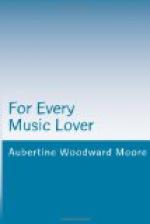Melody, unexhausted and inexhaustible, is the initial force, or, as Dr. Marx has called it, the life-blood of music. Within itself it bears the germ of harmony and rhythm. A succession of tones without harmonious and rhythmic regulation would be felt to lack something. Melody has been designated the golden thread running through the maze of tone, by which the ear is guided and the heart reached. Helmholtz styled it the essential basis of music. In a special sense, it is artistically constructed song. The creation of an expressive melody is a sure mark of genius.
Harmony arranges musical sounds with reference to their union, and is regulated by artistic and aesthetic rules and requirements. It has endless modes of transforming, inverting and intensifying its materials, thus continually affording new means of development. All the intervals and chords used in music had to be discovered, one by one. It often took more than a century to bring into a general use a chord effect introduced by some adventuresome spirit. Our scale intervals are the slowly gained triumphs of the human mind. Modern music did not emerge from the darkness of the past until harmony, as we know it, came into active being.
Both melody and harmony are controlled by rhythm. It is the master force of the musical organism. Before man was the ebb and flow of nature had its rhythm. On this elementary rhythm, the one model music finds in nature, the inventive mind of man has builded the wonderfully impressive art rhythms existing in the masterpieces of music.
Melodies are made up of smaller fragments, known as motives, phrases and periods, or sentences, all of which are judiciously repeated and varied, and derive their individuality from the characteristics of their intervals and rhythms.
A motive is the text of a musical composition, the theme of its discourse. The most simple motive, with proper handling, may grow into a majestic structure. In Beethoven’s Fifth Symphony three G flats in eighth notes, followed by an E flat in a half note, form a text, as of Fate knocking at the door, which, when developed, leads to tremendous conflict ending in victory. Those notes that repeat and modify the motive and are combined under one slur constitute the phrase, which is similar to a clause in a sentence of words. A period, or sentence, in music, comprises a musical idea, complete in itself, though of a nature to produce, when united with other harmonious ideas, a perfect whole.
A simple melody is usually composed of eight measures, or some number divisible by four. There are exceptions, as in “God Save the King,” our “America,” of which the first part contains six measures, the second part eight.
Habit and instinct show us that no melody can end satisfactorily without some cadence leading to a note belonging to the tonic or key chord. Very often the first part of a melody will end on a note of the dominant chord, from which a progression will arise in the second part that leads satisfactorily to a concluding note in the tonic chord.




